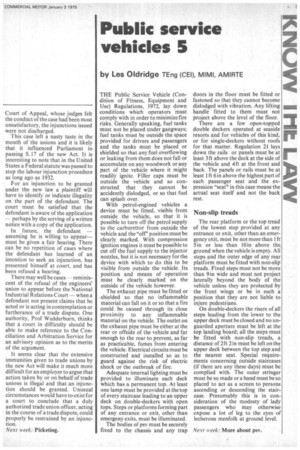Public service vehicles 5
Page 39

If you've noticed an error in this article please click here to report it so we can fix it.
by Les Oldridge TEng (CEO, MIMI, AMIRTE THE Public Service Vehicle (Condition of Fitness, Equipment and Use) Regulations, 1972, lay down conditions which operators must comply with in order to minimize fire risks. Generally speaking, fuel tanks must not be placed under gangways; fuel tanks must be outside the space provided for drivers and passengers and the tanks must be placed or shielded so that any fuel overflowing or leaking from them does not fall or accumulate on any woodwork or any part of the vehicle where it might readily ignite. Filler caps must be outside the vehicle and so constructed that they cannot be accidently dislodged, or so that fuel can splash over.
With petrol-engined vehicles a device must be fitted, visible from outside the vehicle, so that it is possible to turn off the petrol supply to the carburettor from outside the vehicle and the "off' position must be clearly marked. With compression ignition engines it must be possible to cut off the fuel supply to the injector nozzles, but it is not necessary for the device with which to do this to be • visible from outside the vehicle. Its position and means of operation must be clearly marked on the outside of the vehicle however.
The exhaust pipe must be fitted or shielded so that no inflammable material can fall on it or so that a fire could be caused through its close proximity to any inflammable material on the vehicle. The outlet on the exhaust pipe must be either at the rear or offside of the vehicle and far enough to the rear to prevent, as far as practicable, fumes from entering the vehicle. Electrical circuits must be constructed and installed so as to guard against the risk of electric shock or the outbreak of fire.
Adequate internal lighting must be provided to illuminate each deck which has a permanent top. At least one lamp must be provided at the top of every staircase leading to an upper deck on double-deckers with open tops. Steps or platforms forming part of any entrance or exit, other than emergeny exits, must be illuminated.
The bodies of psv must be securely fixed to the chassis and any trap doors in the floor must be fitted or fastened so that they cannot become dislodged with vibration. Any lifting handle fitted to them must not project above the level of the floor.
There are a few open-topped double deckers operated at seaside resorts and for vehicles of this kind, or for single-deckers without roofs for that matter. Regulation 21 lays down the rails or panels must be at least 3 ft above the deck at the side of the vehicle and 4ft at the front and back. The panels or rails must be at least 1 ft 6 in above the highest part of each passenger seat and the expression "sear in this case means the actual seat itself and not the back rest.
Non-slip treads The rear platform or the top tread of the lowest step provided at any entrance or exit, other than an emergency exit, must be not more than 1 ft' 5in or less than 10 in above the ground when the vehicle is empty. All steps and the outer edge of any rear platform must be fitted with non-slip treads. Fixed steps must not be more than 9 in wide and must not project laterally beyond the body of the vehicle unless they are protected by the front wings or be in such a position that they are not liable to injure pedestrians.
On double-deckers the risers of all steps leading from the lower to the upper deck must be closed and nounguarded aperture must be left at the top landing board; all the steps must be fitted with non-slip treads, a distance of 2ft 2 in must be left on the upper deck between the top step and the nearest seat. Special requirements concerning outside staircases (if there are any these days) must be complied with. The outer stringer must be so made or a band must be so placed to act as a screen to persons ascending or descending the stair. case. Presumably this is in consideration of the modesty of lady passengers who may otherwise expose a lot of leg to the eyes of lecherous menfolk at ground level.












































































